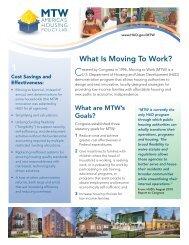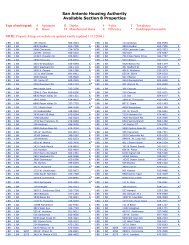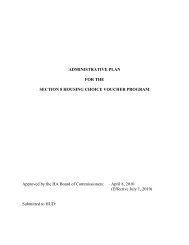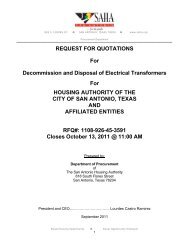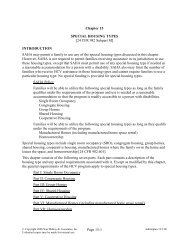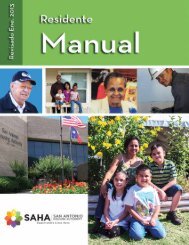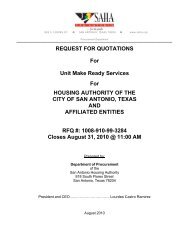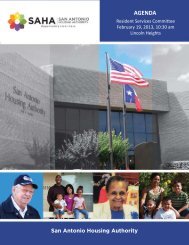AGENDA - San Antonio Housing Authority
AGENDA - San Antonio Housing Authority
AGENDA - San Antonio Housing Authority
- No tags were found...
Create successful ePaper yourself
Turn your PDF publications into a flip-book with our unique Google optimized e-Paper software.
Conclusions15Nearly all households assisted by the <strong>San</strong> <strong>Antonio</strong> <strong>Housing</strong> <strong>Authority</strong> are extremely low income orvery low income (30% and 50% of area median income, respectively). Majority of households areheaded by a single female and have children. A large percentage of households have at least onemember who has a disability. These characteristics are similar to household characteristics drawnfrom a national sample 1 .In 2012, SAHA population did not experience any major changes in overall demographics; however,voucher households and participants have had an increase. Annual updates will help identifydemographic trends over time.Mapping household characteristics is a relatively new way of looking at data for SAHA. Geographiccharacteristics can provide a more in depth perspective on who is assisted through SAHA programs,where they live, and how that location can help understand current conditions and inform futurepolicies.There is a striking difference between public housing and vouchers when households and children areoverlaid with high and low poverty neighborhoods (see maps 1‐4). Households in public housing aremore than three times as likely to live in a high poverty neighborhood compared to voucherhouseholds; and, public housing children are five times as likely than voucher children to live in theseareas. Twenty‐two percent of SAHA households live in high poverty neighborhoods while less than11% of SAHA households live in low poverty neighborhoods.Overall, households in both programs have similar median tenures by census tract, 4.9 years forpublic housing and 5.5 years for vouchers respectively. By mapping median tenure by census tract,pockets of longer and shorter tenures can be observed. Tracts with larger public housing familycommunities on the near west side have a shorter tenure than average while tracts with smallerpublic housing elderly and disabled communities have a longer tenure than average. (see maps 7 &8).General demographic reports are produced monthly by the Planning, Policy, and Public Affairs department.Note: Snapshot data used for this report is intended to be used for planning purposes only. SAHA is under various local, state, and federal reporting requirements that haveindividual data extraction methods and data definitions As a result, data reported for those purposes may slightly differ from the data explored in this report.1National Low Income <strong>Housing</strong> Coalition (2012). Who lives in federally assisted housing? <strong>Housing</strong> Spotlight, Volume 2, Issue 2.818 S. Flores, <strong>San</strong> <strong>Antonio</strong>, TX 78204 | 210.477.6262 | www. saha.org



